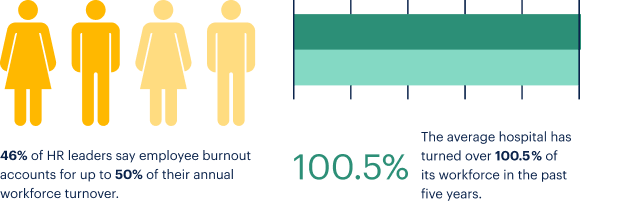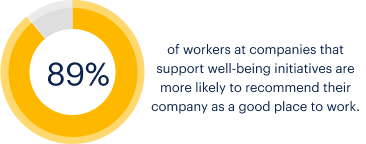
The healthcare industry is no stranger to facing challenges head-on, with employee burnout and workforce shortages being some of the more recent challenges. Creating sustainable and scalable solutions prioritizing employee well-being and development is more critical than ever.
What Are The Biggest Challenges The Industry Is Facing?
Meeting the needs of healthcare workers is no small task, especially in today’s rapidly changing medical industry. To offer high-quality healthcare, effective human resource management is necessary. Employee burnout is one of the top issues HR in healthcare must address, but talent acquisition, training and development, digitization, and high turnover rates are also pressing concerns.
Challenge 1 – Employee Burnout
While workplace stress is generally rising, it’s especially alarming in the high-pressure, understaffed healthcare industry. A survey by CareerBuilder found that 54% of nurses report experiencing high levels of chronic, job-related stress. Healthcare workers are not only taking on the physical stress of long shifts and too many patients but the emotional stress of dealing with illness and death. Employees who experience high levels of job-related stress are more likely to disengage, miss work, have negative interactions, and eventually resign. Healthcare employees’ daily occupational stress can easily lead to burnout if left untreated.
Challenge 2 – Staffing Shortages
The healthcare workforce shortage is a public health crisis. The industry needs more workers to respond to medical advances, new technologies, and an aging population. According to the American Association of Colleges of Nursing, healthcare staffing shortages lead to poor patient outcomes, including hospital-acquired infections, patient falls, and increased chances of death. Staffing shortages create a difficult work environment, particularly in the healthcare industry; therefore, HR professionals must identify ways to optimize limited human resources.
Challenge 3 – High Turnover Rates
The rise in turnover rates is due to multiple factors, such as burnout, a demanding workload, and an aging population. With low supply and high demand, healthcare professionals can leave their jobs to pursue new opportunities. Retention is central to any HR department, but it can be exceedingly time-consuming and challenging in the healthcare industry. A growing need and shrinking talent availability will require more creative solutions to lower turnover and increase retention at all levels of staff.
Challenge 4 – Development Opportunities
Another critical issue in the healthcare industry is workforce training and development. Healthcare HR professionals must juggle time for training that is legally required with training that helps employees develop personally and professionally. Any successful healthcare system requires a well-trained workforce and career development – as it is essential in the rapidly evolving medical industry. As standards of care change and new technologies emerge, organizations must provide ample opportunities for advancement, including leadership development opportunities.

TaskHuman’s Solutions
An increased focus on employees will allow the healthcare industry and its workforce to thrive. Using the TaskHuman platform, your organization can improve morale, attract and retain talent, and create talent development opportunities.
Solutions To Employee Burnout:
Take steps to help reduce burnout by implementing flexible well-being programs that can provide stress management, grief counseling, and healthy work-life practices. As important as it is for employers to offer well-being support, employees can receive the support they may need from their coworkers as well. HR can assist by implementing robust Employee Resource Groups (ERGs). ERGs act as culture-builders that can create a sense of community and drive change toward a more engaging workplace. When done right, ERGs drive the organization’s culture, increase employee engagement, and empower productivity.
Resources for HR leaders:
The TaskHuman Guide To Employee Resource Groups (ERGs)
Workplace Well-Being Program Checklist
Solutions To Staffing Shortages:
Considering the healthcare staffing shortages, competitive compensation and flexible schedules might not be enough to attract and retain talent. Organizations can put their best foot forward by expanding the hiring pool and focusing on empowering their employees as a whole. HR departments can more easily attract talent that will want to grow and develop within an organization by providing flexible well-being programs, career development, and advancement programs. Leadership coaching and mentorship programs are great places to start.
Resources for HR leaders:
Lead and Succeed Through Uncertainty
Watch On-Demand: Introduction To Diversity, Equity, Inclusion, and Belonging (DEIB) Programs
Solutions To High Turnover Rates:
With the average cost of turnover for a bedside RN being $46,100, resulting in the average hospital losing between $5.2m – $9.0m, it’s crucial for healthcare organizations to focus on retention. By improving company culture, HR departments can create a space where employees will want to grow and thrive. Start by building a sense of community with ERGs and Diversity, Equity, Inclusion, and Belonging (DEIB) programs. Additionally, managers can empower a learning culture that drives higher productivity, efficiency, and engagement with strategies that consist of regular one-on-ones, consistent feedback and praise, tangible goals, and career development. Management and leaders must be equipped with proper training to develop soft skills and implement these strategies.
Resources for HR leaders:
Watch On-demand: Strengthen Company Culture During Restructuring
A Guide To Dev An Adaptable Leadership Framework
Solutions To Development Opportunities:
In order to retain staff and fill new positions, organizations must provide ample opportunities for advancement, including leadership development opportunities. It can be difficult to find time and costly to provide career development opportunities that employees want, but the expenses of hiring and training new employees are much higher. Due to the demanding nature of the healthcare industry, investing in flexible learning and development programs, like a mentorship program, pays off in the long run, both in terms of employee retention and greater capability.
Resources for HR leaders:
Why Mentorship Matters To Company Growth

Employee Growth & Support At Scale
The TaskHuman platform connects a global network of professional expertise to your employees, unlocking their fullest potential, improving performance and engagement, and providing preventative support – instantly.
Sources: Wrike NSI Nursing Solutions Forbes
[hubspot type=cta portal=8109744 id=f6c644b4-ae9e-48c1-8264-9897e5509051]